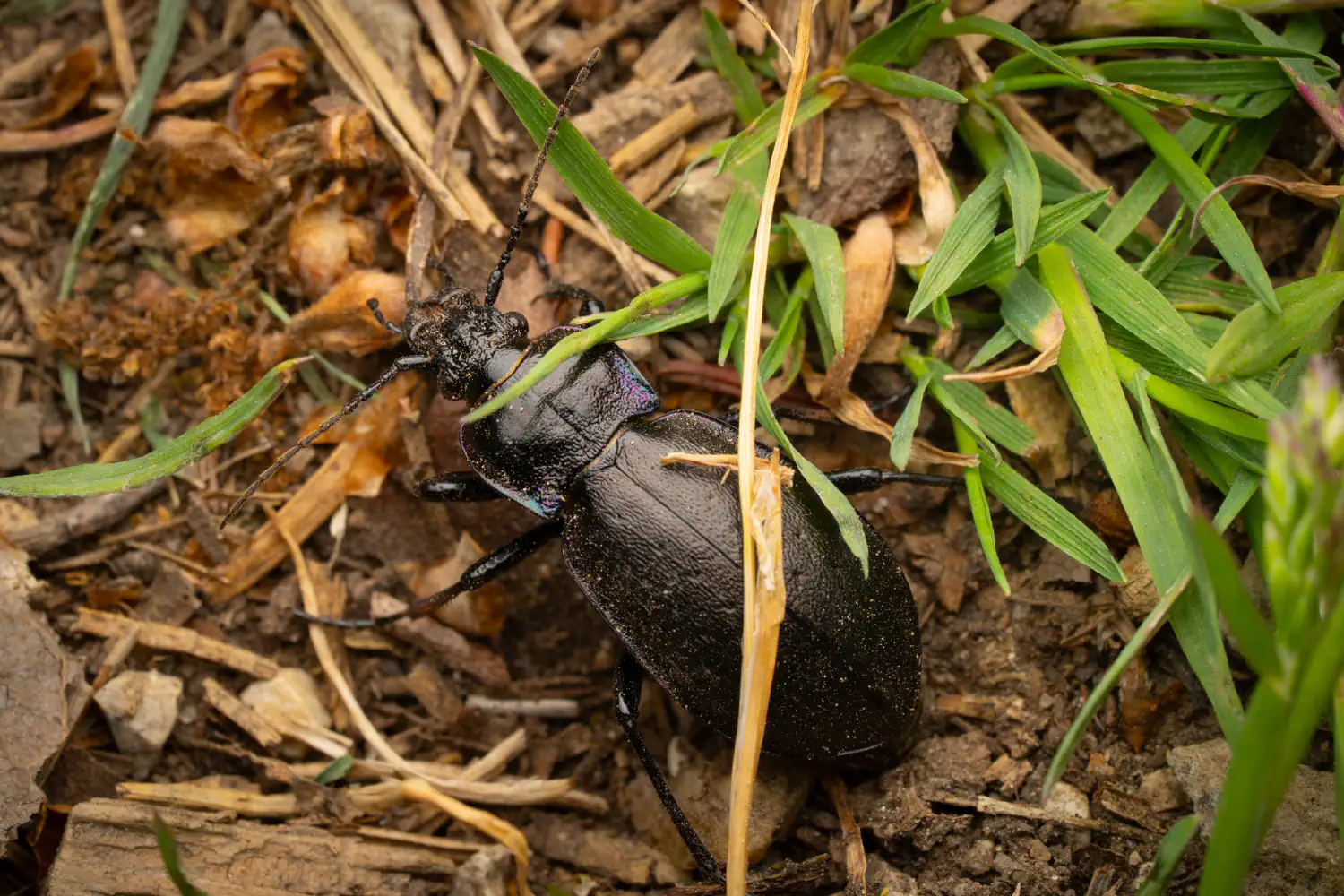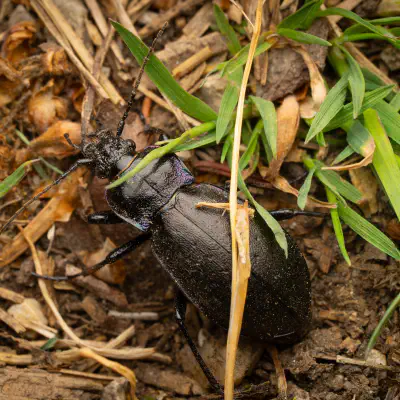Ground Beetles Lat. “Carabidae“
Ground beetles are a large, cosmopolitan family of beetles, Carabidae, with more than 40,000 species worldwide, around 2,000 of which are found in North America and 2,700 in Europe. It is one of the ten largest animal families, as of 2015.
Hierarchy
Description and ecology
Although their body shapes and coloring vary somewhat, most are shiny black or metallic and have ridged wing covers (elytra). The elytra are fused in some species, particularly the large Carabinae, rendering the beetles unable to fly. The species Mormolyce phyllodes is known as violin beetle due to their peculiarly shaped elytra. All carabids except the quite primitive flanged bombardier beetles (Paussinae) have a groove on their fore leg tibiae bearing a comb of hairs used for cleaning their antennae.
Relationship with humans
As predators of invertebrates, including many pests, most ground beetles are considered beneficial organisms. The caterpillar hunters (Calosoma) are famous for their habit of devouring prey in quantity, eagerly feeding on tussock moth (Lymantriinae) caterpillars, processionary caterpillars (Thaumetopoeinae) and woolly worms (Arctiinae), which, due to their urticating hairs, are avoided by most insectivores. Large numbers of the forest caterpillar hunter (C. sycophanta), native to Europe, were shipped to New England for biological control of the gypsy moth (Lymantria dispar) as early as 1905. A few species are nuisance pests. Zabrus is one of the few herbivorous ground beetle genera, and on rare occasions Zabrus tenebrioides, for example, occurs abundantly enough to cause some damage to grain crops. Large species, usually the Carabinae, can become a nuisance if present in large numbers, particularly during outdoor activities such as camping; they void their defensive secretions when threatened, and in hiding among provisions, their presence may spoil food. Since ground beetles are generally reluctant or even unable to fly, mechanically blocking their potential routes of entry is usually easy. The use of insecticides specifically for carabid intrusion may lead to unfortunate side effects, such as the release of their secretions, so it generally is not a good idea unless the same applications are intended to exclude ants, parasites or other crawling pests. Especially in the 19th century and to a lesser extent today, their large size and conspicuous coloration, as well as the odd morphology of some (e.g. the Lebiini), made many ground beetles a popular object of collection and study for professional and amateur coleopterologists. High prices were paid for rare and exotic specimens, and in the early to mid-19th century, a veritable “beetle craze” occurred in England. As mentioned above, Charles Darwin was an ardent collector of beetles when he was about 20 years old, to the extent that he would rather scour the countryside for rare specimens with William Darwin Fox, John Stevens Henslow, and Henry Thompson than to study theology as his father wanted him to do. In his autobiography, he fondly recalled his experiences with Licinus and Panagaeus, and wrote:
No poet ever felt more delight at seeing his first poem published than I did at seeing in Stephen’s Illustrations of British Insects the magic words, “captured by C. Darwin, Esq.”
Evolution and systematics
The Adephaga are documented since the end of the Permian, about 250 million years ago (Mya). Ground beetles evolved in the latter Triassic, having separated from their closest relatives by 200 Mya. The family diversified throughout the Jurassic, and the more advanced lineages, such as the Harpalinae, underwent a vigorous radiation starting in the Cretaceous. The closest living relatives of the ground beetles are the false ground beetles (Trachypachidae) and the tiger beetles (Cicindelidae). They are sometimes even included in the Carabidae as subfamilies or as tribes incertae sedis, but more preferably they are united with the ground beetles in the superfamily Caraboidea, or Geadephaga. Much research has been done on elucidating the phylogeny of the ground beetles and adjusting systematics and taxonomy accordingly. While no completely firm consensus exists, a few points are generally accepted: The ground beetles seemingly consist of a number of more basal lineages and the extremely diverse Harpalinae, which contain over half the described species and into which several formerly independent families had to be subsumed.
Further reading
E. Csiki (1946). Die Käferfauna des Karpaten-Beckens [The beetle fauna of the Carparthian basin] (in German). Budapest. pp. 71–546.{{cite book}}: CS1 maint: location missing publisher (link) K. Kult (1947). Klíč k určování brouků čeledi Carabidae Československé republiky [Key to the beetles of family Carabidae of the Czech Republic] (in Czech). Prague.{{cite book}}: CS1 maint: location missing publisher (link) C. H. Lindroth (1942). Coleoptera, Carabidae. Svensk Insectenfauna, Vol. 9 (in Swedish). Stockholm. pp. 1–260.{{cite book}}: CS1 maint: location missing publisher (link) Edmund Reitter (1908–1917). Die Käfer des Deutschen Reiches [The beetles of the German Empire] (in German). Stuttgart: K. G. Lutz.
External links
Carabidae of the World Štrunc V. (2022): Ground Beetles of Africa, Afrotropical Region, 504 species in 111 genera of the superfamily Buprestoidea
Ancestry Graph
Further Information
„Ground Beetles“ on wikipedia.org
„Ground Beetles“ on iNaturalist.org
Copyright

This article uses material from the Wikipedia article Carabidae the free encyclopedia Wikipedia which is released under Creative Commons Attribution-ShareAlike 4.0 International License). On Wikipedia a list of authors is available.

Little beings in print
Order our calendars and books today!
Compiled with love. Printed sustainably. Experience our little beings even more vividly in print. All our publications are available for a small donation.


